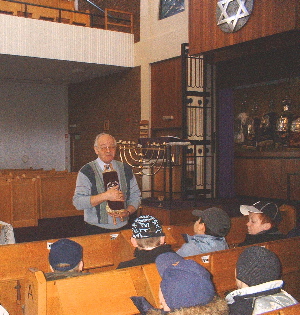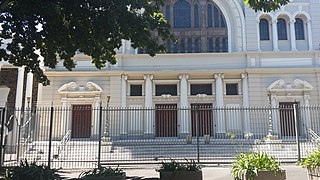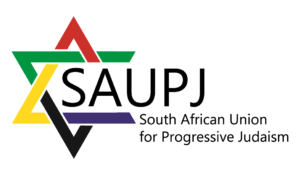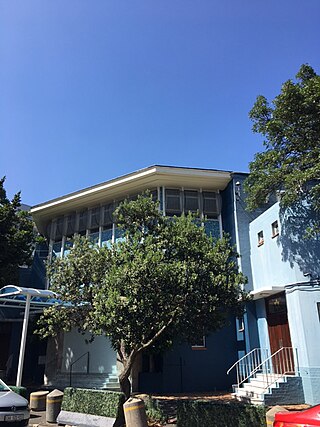
Glenhazel is a suburb of Johannesburg, South Africa. It is located in Region E, bordering Fairmount, Sandringham, Lyndhurst and Percelia Estate. The area lies on a sloping hill with a park in the valley. It is known for its large Jewish population as well as for being home to the largest Jewish kosher hub in Johannesburg, which attracts many Jewish tourists.

Vredehoek is a residential suburb of Cape Town, South Africa, located at the foot of Table Mountain and Devil's Peak. It is sandwiched between the two neighbouring suburbs of Oranjezicht and Devil's Peak Estate, the latter of which is often considered a sub-suburb of Vredehoek as they both fall under the neighbourhood watch community called DPV - Devil's Peak & Vredehoek.

The Giffnock Newton Mearns Synagogue, commonly known as Giffnock Shul, is an Orthodox Jewish congregation and synagogue, located at 222 Fenwick Road in Giffnock, East Renfrewshire, on the south side of Glasgow, Scotland, in the United Kingdom. The synagogue is the largest in Scotland and also features a religious day school for both children and teenagers.

Gardens is an affluent inner-city suburb of Cape Town located just to the south of the city centre located in the higher elevations of the "City Bowl" and directly beneath Table Mountain and Lion's Head. It is home to several national museums such as Iziko South African National Gallery and the Iziko South African Museum. The University of Cape Town also houses its Fine Arts department in the suburb, at Michaelis School of Fine Art. Company's Garden, South Africa's oldest garden, a public park and heritage site is a focal point of the suburb. The area is also home to the oldest synagogue in Southern Africa, the Old Shul and its successor, the Gardens Shul, "The Mother Synagogue of South Africa."

Breed Street Shul, also known as Congregation Talmud Torah of Los Angeles or Breed Street Synagogue, is a former Orthodox Jewish synagogue in the Boyle Heights section of Los Angeles, California, in the United States. It was the largest Orthodox synagogue west of Chicago from 1915 to 1951, and is listed in the National Register of Historic Places.

The Gardens Shul, formally the Cape Town Hebrew Congregation (CTHC), also called the Great Synagogue, is a Modern Orthodox Jewish congregation and synagogue, located in the Company Gardens, in the Gardens neighborhood of Cape Town, South Africa. The congregation was established in 1841, making it the oldest Jewish congregation in South Africa.
The Oxford Shul is an Orthodox Jewish congregation and synagogue, located in Riviera, near the suburbs of Saxonwold, Houghton and Killarney, in Johannesburg, in the region of Gauteng, South Africa. The congregation was established in 1943 and moved into its current building in 1962. The sanctuary is one of the largest in the Southern Hemisphere, with seating for 1,500 congregants.

Anshei Minsk is a synagogue in the Kensington Market neighbourhood of Toronto, Ontario, Canada. It was founded in 1912 by poor Jewish immigrants from what is now Belarus, which at the time was part of the Russian Empire. The current Byzantine Revival building was completed in 1930.
Shaarey Tphiloh is a Modern Orthodox Jewish congregation and synagogue located at 400 Deering Avenue, in Portland, Maine, in the United States. The congregation says it is the oldest continuously operating synagogue in Portland. The name of the synagogue literally means "Gates of Prayer" in Hebrew.

The Chassidim Shul, also known as the Chabad House, is a former Hasidic Jewish congregation and synagogue, located in Yeoville, Johannesburg, in the district of Gauteng, South Africa. The congregation worships from a synagogue located in the Savoy Estate.
Rabbi Barry Marcus is a South African rabbi. He retired as senior minister of Central Synagogue, Great Portland Street in London in 2018 after serving the congregation for over 23 years. He is notable for his rabbinical and pastoral duties in the UK, Israel and South Africa.
The Great Park Synagogue is an Orthodox Jewish congregation and synagogue, located at 75 4th Street, in Houghton, Johannesburg, in the region of Gauteng, South Africa.
Beit Emanuel is a Progressive Jewish congregation and synagogue, located in Parktown, a suburb of Johannesburg, in the district of Gauteng, South Africa. The synagogue was established in 1954 and is one of the largest Progressive Jewish congregations in South Africa. It is an affiliate of the South African Union for Progressive Judaism (SAUPJ), which is part of the World Union for Progressive Judaism (WUPJ).

The South African Union for Progressive Judaism (SAUPJ) is an affiliate of the World Union for Progressive Judaism and supports 11 progressive congregations. Rabbi Moses Cyrus Weiler, a founder of Reform Judaism in the country, led the country's first Reform synagogue, Temple Israel in Hillbrow, Johannesburg. Weiler is credited with growing the movement, to represent 15-17% of South African Jewry and establishing 25 congregations in the country. A 2020 joint study by the Institute for Jewish Policy Research and the University of Cape Town showed that 12% of Jews identified as Progressive and that in relative terms the progressive strands are increasing after falling to 7% in 1998 and 2005 studies. In Johannesburg, the community accounts for 7% of the city's Jewry, rising to 18% in Cape Town and 25% in Durban.
The Temple Israel, also known as the Cape Town Progressive Jewish Congregation (CTPJC), is a Progressive Jewish congregation, located in Cape Town, with three synagogues located in each of Green Point, Wynberg and Milnerton, in the Western Cape region of South Africa. As three centres combined, they are the largest Progressive congregation in South Africa, and the second largest Jewish congregation in Cape Town after Marais Road Shul in Sea Point.
Moses Cyrus Weiler was a Latvian-born South African rabbi and founder of Reform Judaism in the country. He was Chief Minister of the United Jewish Progressive Congregation and served as rabbi of Temple Israel in Hillbrow, Johannesburg, the mother synagogue of the country's Reform movement. He is credited with growing the movement, with 25 congregations established during his tenure. He made aliyah to Israel in 1958, where he spent the second part of his life.
Rabbi Dr David Sherman was a South African and American rabbi. He was the first spiritual leader of a Reform congregation in Cape Town, where he led Temple Israel in Green Point.

The Marais Road Shul, formally the Green & Sea Point Hebrew Congregation (G&SPHC), is a Modern Orthodox synagogue in Sea Point, a seaside suburb of Cape Town. The congregation was first established in 1926, and the synagogue was completed in 1934. It had initially intended to become a branch of the Gardens Shul in the City Bowl, but opted for independence, and became the larger of the two. It is the largest Jewish congregation in South Africa, and by 1994, it had become the largest in the South Hemisphere. The Sephardi Hebrew Congregation, established in 1960, also operates a shul from the G&SPHC's Weizmann Hall on Regent Road in Sea Point.

The Muizenberg Shul, formally the Muizenberg Hebrew Congregation, is a Modern Orthodox Jewish congregation and synagogue, located in Muizenberg, in Greater Cape Town, in the Western Cape region of South Africa. The congregation was established in 1924, and the synagogue was completed in the following year.
The Beit Midrash Morasha is a Modern Orthodox Jewish congregation and synagogue, located on Arthur's Road, in Sea Point, a seaside suburb of Cape Town, South Africa. The congregation was first established in 1897 in District Six, before relocating to Vredehoek in 1945. It moved to its present location in Sea Point in 1954.


















